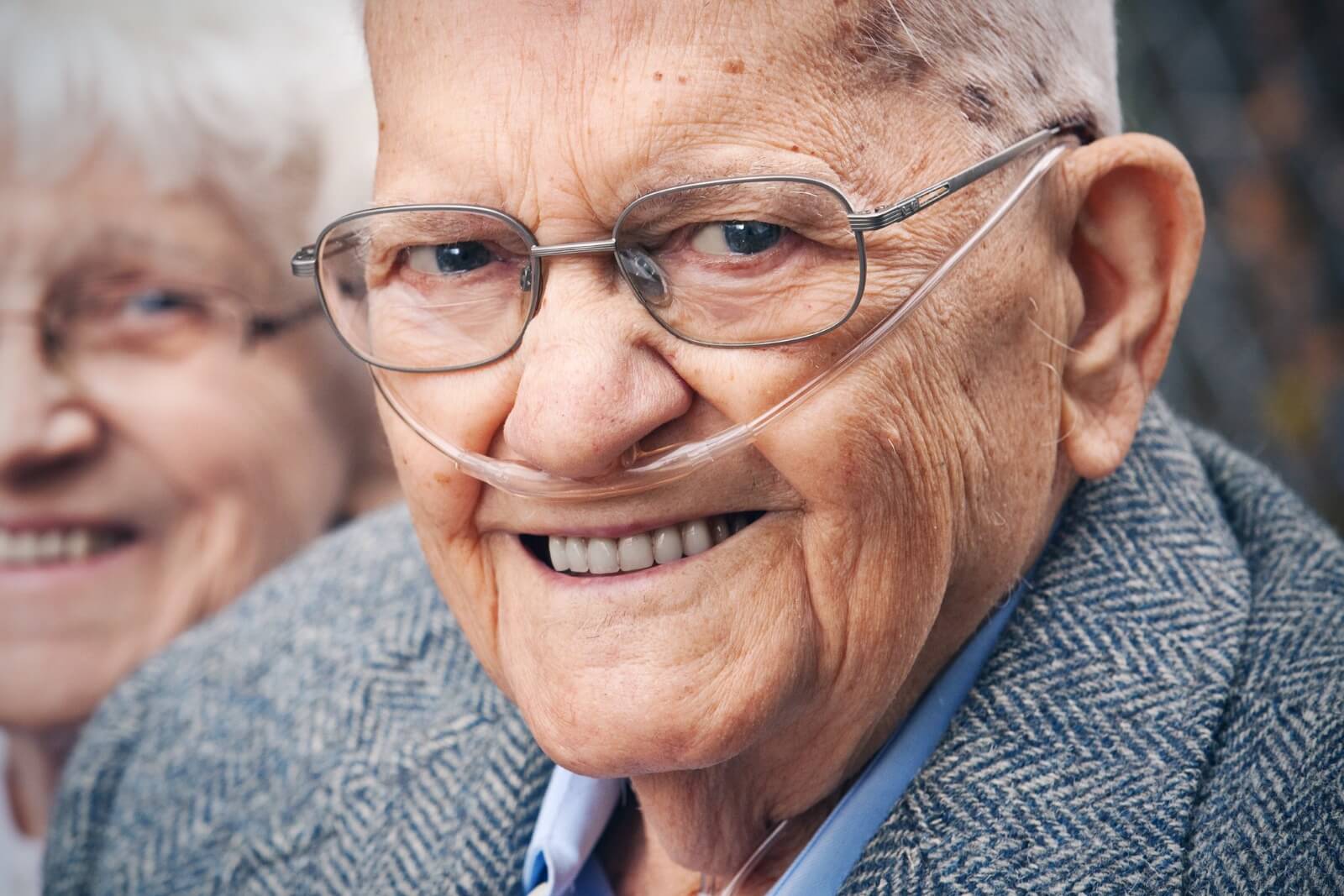[Last updated December 3, 2024]

Almost seven in 10 seniors aged 65 and over need long-term care at some point in late adulthood, and roughly 20% will need it for more than five years. This necessary care doesn’t come cheap: The median monthly cost of assisted living in the United States is over $5,000, and for nursing home care it is over $8,000 for a semiprivate room. For older adults on fixed incomes, paying for long-term care can be difficult.
Senior U.S. military Veterans and their spouses may have access to over $2,000 in additional income each month to help pay for care if they qualify for the Aid and Attendance benefit. Here, we’ll explain this benefit, who qualifies, and how Veterans and their spouses can qualify and apply for this pension to help them pay for the care they need.
How much money does the Aid and Attendance benefit pay?
Each year in December, the U.S. Department of Veterans Affairs (VA) determines the maximum monthly benefit amounts a recipient can get for the following year. These benefit amounts are “maximum” possible benefits, meaning that a recipient can potentially receive that amount based on these factors:
- The Veteran’s marital status.
- Whether the Veteran, the spouse, or both meet the health criteria.
- The applicant’s income.
The monthly pension amount a claimant can receive is based on their income after paying for care, marital status, and who needs care. See the chart below for the 2025 maximum monthly benefits.
| Veteran’s marital status and who needs care | 2025 maximum monthly benefit |
| Veteran is married and needs care. | $2,795 |
| Veteran is not married and needs care. | $2,358 |
| Veteran is married, and only the spouse needs care. | $1,851 |
| Veteran is deceased, was married to the spouse at the time of the Veteran’s passing, and the spouse needs care. | $1,515 |
What care can you pay for with Aid and Attendance benefits?
VA sends the Aid and Attendance benefits directly to the recipient. The funds are considered income. Since successful applicants have significant care needs and limited income, they utilize these funds to pay for long-term care. Let’s look at some examples of senior care services that Veterans and their spouses can use the money to cover:
- Assisted living: Senior living communities like assisted living facilities offer various services to help older adults live comfortable, safe, maintenance-free lives with abundant social and recreational opportunities. Residents may have a room or apartment of their own, have access to communal dining rooms and living spaces, and enjoy included services like daily housekeeping and meals (depending on the state you live in). Residents can also access medication management, personal care aides to help with bathing, dressing, or other personal care tasks, laundry services, and more.
- Nursing home care: This type of residential long-term care facility is for people who need significant help completing activities of daily living, such as bathing, getting dressed, eating, toileting, transferring (such as to and from bed), and moving around. These communities also provide meals, activities, and skilled nursing care.
- Memory care: The Alzheimer’s Association estimates that one in nine adults aged 65 and over have Alzheimer’s disease, which is one of the most common forms of dementia. Alzheimer’s and other dementias impact the brain’s functioning. Individuals with these conditions experience memory and cognitive issues. Many senior living communities (such as assisted living communities and nursing homes, described above) offer memory care services that can meet the unique needs of people with dementia. If a person with dementia and their family choose for the individual to remain living at home, in-home memory care services can also meet their needs.
- Home care: Home care includes a range of services in a person’s home to ensure the individual is safe and comfortable. Many older adults want to age in place, which is to continue living in their homes for as long as possible rather than moving to a senior care facility. Many home care services, such as homemaker services (laundry, meal preparation, and more), personal care services (assistance with bathing and dressing, for example), and others, can help seniors continue to live in their homes.
- Adult day care: Adults who live at home may also require supervision or assistance during daytime hours when family caregivers cannot be present. For instance, an older adult may live with their adult child who works on weekdays. During this time, the older adult can attend an adult day care program to socialize with peers, participate in planned activities, and receive care in a safe and comfortable environment. At the end of the day, the senior returns home when the family caregiver finishes their workday and can provide care at home.
Because VA pays the Aid and Attendance benefits directly to the recipient, the money is available for care in just about any way the person wants to use it.
Do I qualify for Aid and Attendance?
A person interested in receiving Aid and Attendance benefits must meet all areas of criteria: The Veteran must have qualifying military service, the household income and net worth must not exceed the asset limit, and the applicant must meet health requirements. See more about the requirements below.
Military service requirements for Aid and Attendance benefits
- The beneficiary is a Veteran or surviving spouse of a Veteran.
- The Veteran had an honorable, medical, or general discharge.
- The Veteran served qualifying military service of at least one day of active duty during a wartime period, such as World War II, the Korean Conflict, the Vietnam Era, or the Gulf War.
- The Veteran served at least 90 days of active duty in a U.S. military branch. If the Veteran started active duty after September 7, 1980, they must have served 24 months of active duty.
Income and net worth requirement for Aid and Attendance benefits
- VA will review how much of the household’s monthly income is spent on care to determine if they receive a full, partial, or no benefit.
- The beneficiary’s household net worth does not exceed the limit of $159,240 in 2025.
Health criteria for Aid and Attendance
The applicant meets at least one of the following health criteria:
- The beneficiary requires assistance with at least two activities of daily living, such as eating, bathing, dressing, and transferring.
AND/OR
- The beneficiary needs to live in a senior living community that protects their safety due to physical or cognitive issues such as dementia, Alzheimer’s disease, Parkinson’s disease, or other health or medical issues.
AND/OR
- The beneficiary has macular degeneration or is legally blind in both eyes.
You can also complete an online questionnaire to learn if you may qualify.
How to get Aid and Attendance approval
Applicants must gather the necessary documentation to demonstrate they meet these criteria and successfully complete the application, which is over 30 pages long. Interested Veterans and their spouses can apply to VA independently. It may take six months or more to receive a decision. If they are approved, they will receive retroactive benefits to the first of the month after the claim was opened (when they filed an Intent to File form or submitted the entire application). Applicants should note that if VA requests financial, military, or health documentation they did not submit with the application, this will delay their potential approval and, ultimately, receipt of benefits.
Another method of applying for Aid and Attendance benefits is to utilize a third-party company that has staff with specialized knowledge of the application, its requirements, and necessary documentation for approval.
ElderLife Financial Services is staffed with software experts with experience in helping families successfully apply for and receive Aid and Attendance benefits. ElderLife Financial’s tiers of software offer something for every family regardless of their budget or needs. ElderLife Financial has complimentary and paid services that help applicants apply for the benefit:
- Complimentary service: ElderLife Financial will provide all four VA forms necessary to apply for the benefits in one 30-page application bundle by PDF.
- Basic service: ElderLife Financial can give the applicant access to its online software to complete the application easily in about an hour. This software prompts the applicant through the process and alerts them when it detects potential errors before completing the application. Applicants receive a PDF to sign, send, and save for their records.
- Premium service: ElderLife Financial’s white-glove service helps the applicant from start to finish and after the application.
- ElderLife’s team of software experts can answer questions about how to use the software by phone or email.
- An ElderLife Financial benefits specialist will conduct a final review of the application once it is complete before submission.
- ElderLife Financial’s team of software experts will continue to be available to clients for ongoing support.
How to start your Aid and Attendance application
With ElderLife Financial, the Aid and Attendance application process can be as easy as you need it to be. Whether you utilize ElderLife Financial’s premium service or its DIY online platform to complete the application easily, you will be on your way to potentially receiving over $2,000 of additional income each month to pay for the care you need and deserve.
The first step to getting your application started is to choose your service with ElderLife Financial Services, determine your eligibility, and work with the team to submit your application.








